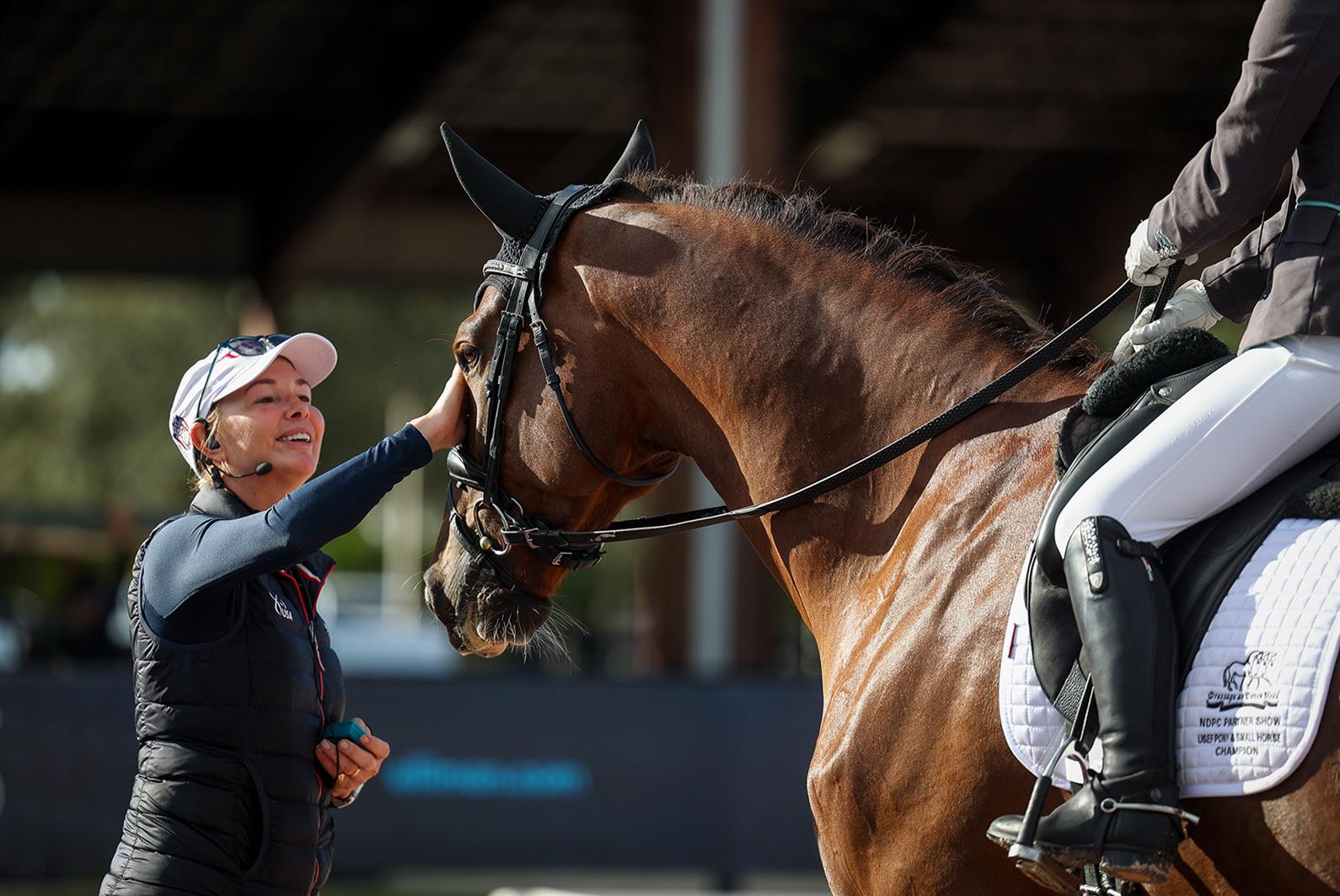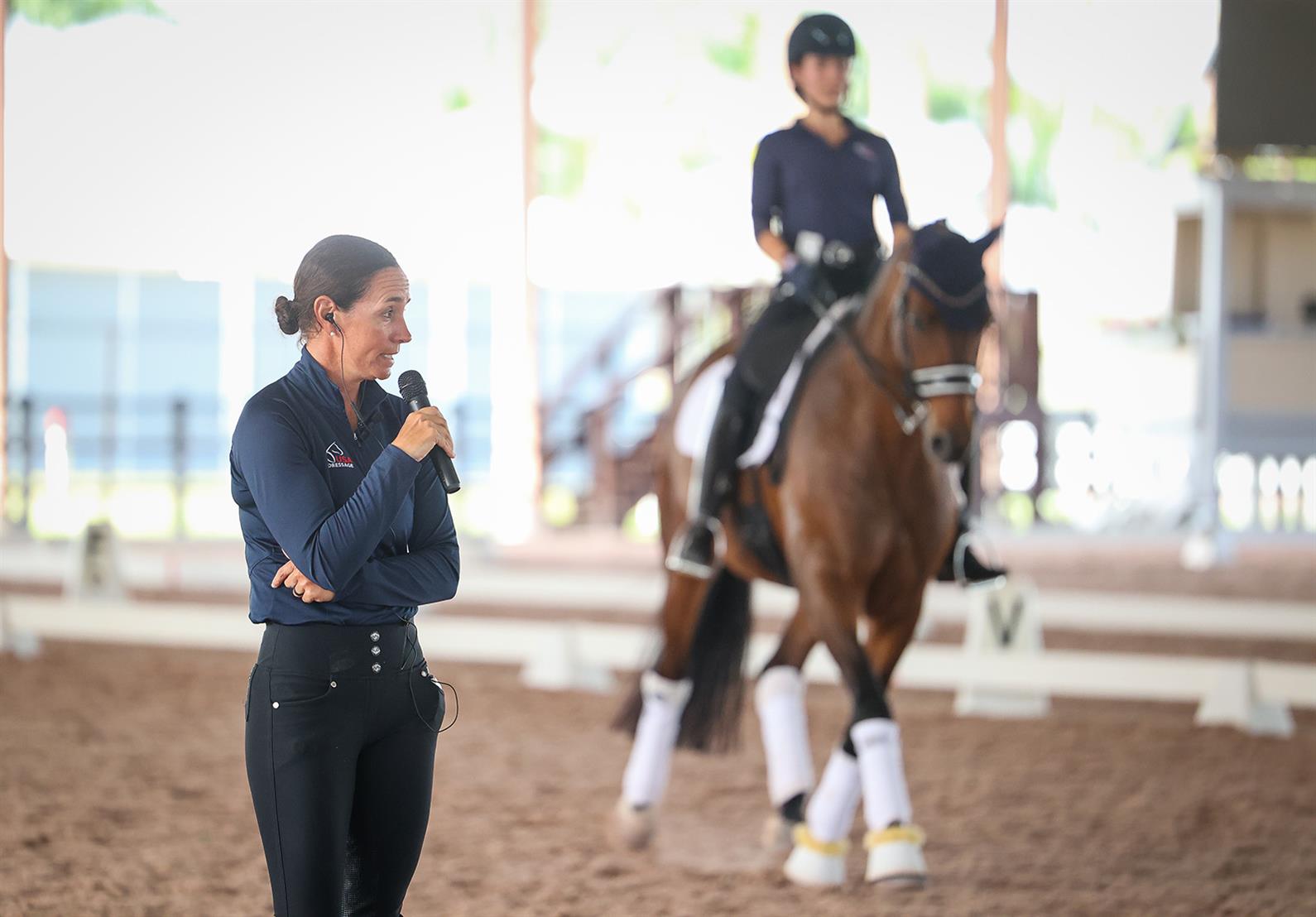Each winter, a group of junior and young dressage athletes are invited to learn from top equine professionals at the Robert Dover USEF Horsemastership Week presented by Zen Elite Equestrian Center. In addition to a lecture and demonstration from Dover himself, the athletes receive mounted instruction from clinicians over three days, culminating in a mock competition where they each perform a test in front of a judging panel. This year’s clinicians for the mounted sessions were Katherine Bateson-Chandler, Ali Brock, Katie Duerrhammer, Olivia LaGoy-Weltz, and Shelly Francis. Here are a few words of wisdom from the pros at this year’s Clinic.

Dressage is more than a set of tricks.
“Dressage can be like training dogs,” said Robert Dover. “You can do it in a lot of ways, and they can learn to do things that look the same, but the difference between a perfectly trained dog, like a service dog, versus a dog that can do all these cute tricks, is one can save a life and the other can roll over and play dead.
“With horses, yeah, you can train them all sorts of ways to do all the tricks there are in the grand prix,” he continued. “The difference when it comes to making a team for the U.S., is that a beautifully trained horse goes from movement to movement, transition to transition, beautifully connected like a perfectly sewn quilt that has all of these elements that are sewn seamlessly together.”
Energy is the beginning of everything.
In this dressage theory lecture, Dover talked about the beauty of a dressage horse set in motion by the driving aids and being shaped by the bending aids and aids of opposition. He likened it to an artist using a pottery wheel.
“The [pottery wheel] goes around, almost self-propelling, and then what happens is you put your hand on the clay and it becomes all of these beautiful shapes,” he said. “The thing that makes the pottery wheel start going around is energy. It’s the beginning of all of it. It’s the beginning of everything."
Adding another metaphor, Dover pointed to the overhead lights in the arena.
“There’s a circuit of electricity that’s lighting up this lightbulb,” he said. “If you broke that circuit, no matter where, the bulb would flicker and go out. If you think of a horse’s brain like that bulb, you want it to be glowing all the time, which means the energy has to be constantly circulating. How do we create energy in the horse? We have the set of driving aids: seat, inside leg, and outside leg.”
During a mounted session, Katherine Bateson-Chandler reiterated this point while working on lengthening and shortening the horse’s stride with Autumn Vavrick and her 2007 Hanoverian gelding, Dante.
“You’ve got to have something to collect,” she said. “What you’re collecting is the energy; you’ve got to have the energy to collect.
“You want to feel this ball of energy; like you’re sitting on the highest point of him when you’re in the half halt, so he’s got a little bit of that stretching, round feeling and he’s underneath. Then, you’ve got that circuit of energy,” she said. “Otherwise, it’s kind of like a hose that’s got a kink in it. Feel like you’ve got a nice round hose where the water can flow—where the energy can flow.”

Position affects everything.
“The first thing I look at with riders is how they’re sitting on the horse, and if I was to pull the horse out from under them, would they land on their feet,” said Ali Brock. “What I’m looking for is that the rider is vertical and their knee is in front of their hip. The stirrup has to be under the knee. And then I look at where their seat bones are pointed.”
While working with Sydney Lipar and Zerragamo, Denise Lipar’s 2012 Westphalian gelding, Brock explained that a horse that tends to be strong or roots at the bridle can learn to take advantage of a rider tilting forward with their seat bones angled back.
“He knows he can move you and pull you around when your lower leg is that far back and your upper body is that far forward,” she said. “He needs a balance point from you where you’re upright and vertical, almost like you’re his carousel pole.”
For riders who habitually sit in front of or behind the vertical, it takes work to adjust to a truly vertical seat.
“Our brain gets used to a certain way of going, and then our perception thinks that we’re one way when we’re not.”
When something is hard, break it down to something easier.
“I always like to think, if this is the hard thing for them, how can I break it down to find other places where the same thing is easy for them,” said Katie Duerrhammer while working with M.K. Connatser and Sun of Soul, a 2011 Warmblood mare who was stiff to the canter aids. “Walk-trot transitions are obviously very easy for her. She’s probably done them for a long time. So, if the reactivity to your leg is harder at the canter, instead of just working on that every day, how can you make it simpler for her to understand? If you can work gently on the same theme throughout the whole work, she’s going to feel less like you’re picking on what’s hard.”
Duerrhammer cautions that this method won’t immediately fix the problem, but it will help set the horse up for success.
“Even though you know that the reactivity to your leg and her ability to close up her hind leg and stay loose in the back is harder for her in the canter, if you can pick on it in other places that are a little bit easier for her to understand, then when you come to the canter, she’ll say, ‘Okay, this is hard, but she really has been telling me to do the same thing throughout the ride and I’ve been successful at it, so maybe I’ll be successful at the canter too,’” Duerrhammer said. “If you can always find a way to make it easier to understand, and easier on their bodies, you’ll have a better time training them.”

Mistakes happen. Don’t let them take you out of the moment.
While working on four tempis with Lexie Kment and Fernando V, a 2010 KWPN gelding owned by Stacey Knox, Olivia LaGoy-Weltz advised not letting one miscounted set affect the next one.
“If there’s a mistake, you’ve got to stay in the moment so that you’re not late on the next set,” she said. “Doesn’t matter; mistakes are going to happen. You just go on with it.”
This mindset applies to any part of a dressage test, where each movement is judged independently and is a fresh opportunity to succeed—if you keep your focus.
“Don’t pick on yourself too much for a mistake,” said LaGoy-Weltz. “If you get to into thinking, ‘I made a mistake,’ or ‘I’m going to miss it,’ or, ‘I’m not good at changes,’ and get distracted by the mistake, it takes you out of the moment to say, ‘Okay, next movement.’ Obviously, we don’t want to make a mistake, but it has to be okay if you do, and you say, ‘Okay. Next time.’”
Work in intervals, especially for physically challenging movements.
Shelly Francis worked with Ella Fruchterman on preparing for pirouette work with Holts Le’Mans, Todd Fruchterman’s 2011 Danish Warmblood gelding, using an exercise that involved developing a very collected canter. It took a few tries to get the desired result, and Francis encouraged careful management of that type of work.
“It’s better if you can get it earlier in the session so he doesn’t have to canter as long per session,” she said. “You want to give him little short breaks in between things. Try to get it done in the first half and then don’t try to stay [in the collection] all the way around, because if you’re going to work it multiple times, you don’t want to do it so much and so long that he gets sore.
“You can always skip a day and work it like interval training,” said Francis. “Think, ‘We did a lot of sitting down in the canter today, so we won’t do it for a day or two.’ That way they develop a little quicker without getting as sore, and then they’re less resistant because they’re not sore.”
Watch the 2023 Robert Dover Horsemastership Clinic Week on USEF Network.


